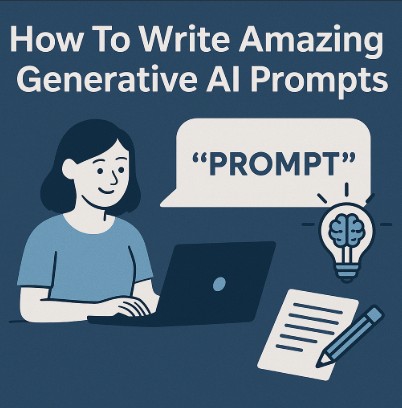Generative AI tools are revolutionizing various industries, offering unprecedented capabilities for content creation, code generation, and problem-solving. However, the quality of the output heavily depends on the quality of the input – the prompt. This comprehensive guide will teach you how to write amazing generative AI prompts, transforming you from a novice to a prompt engineering expert. Whether you’re a DevOps engineer fine-tuning infrastructure scripts, a data scientist generating complex datasets, or a backend developer needing assistance with code, mastering prompt writing is essential for maximizing your AI’s potential. This guide provides actionable strategies and examples to help you achieve outstanding results with any generative AI model.
Table of Contents
- 1 Understanding the Fundamentals of Generative AI Prompts
- 2 Crafting Effective Prompts: Techniques and Best Practices
- 3 Examples of Amazing Generative AI Prompts
- 4 Frequently Asked Questions (FAQ)
- 4.1 Q: What are some common mistakes to avoid when writing AI prompts?
- 4.2 Q: How can I improve the quality of my AI-generated outputs?
- 4.3 Q: Which generative AI models are best for different tasks?
- 4.4 Q: Are there any tools or resources to help with prompt engineering?
- 4.5 Q: Can I use generative AI for sensitive data?
- 5 Conclusion
Understanding the Fundamentals of Generative AI Prompts
What Makes a Good Prompt?
A good prompt is clear, concise, and specific. It provides the AI with enough information to understand your request without being overly verbose or ambiguous. It should also consider the specific capabilities and limitations of the AI model you are using.
Key Elements of an Effective Prompt
- Clear Objective: State your desired outcome explicitly. What do you want the AI to generate?
- Specific Instructions: Provide detailed instructions on the format, style, length, and other relevant parameters of the output.
- Context and Background: If necessary, provide background information or context to help the AI understand the task better.
- Constraints and Limitations: Specify any constraints or limitations, such as word count, style guidelines, or specific keywords to include or avoid.
Crafting Effective Prompts: Techniques and Best Practices
Specify the Desired Output Format
Clearly indicate the desired format of the output. For example, “Write a Python function that…”, “Generate a JSON object containing…”, or “Create a 500-word essay on…”
Use Keywords Strategically
Incorporate relevant keywords to guide the AI’s response. The more specific your keywords, the more accurate the results. For instance, instead of “write a story,” try “write a short science fiction story about a robot exploring Mars.”
Iterative Prompt Refinement
Don’t expect perfection on the first try. Experiment with different prompt variations, adding or removing keywords, adjusting the level of detail, and refining the instructions based on the initial results. This iterative process is crucial for achieving optimal outcomes.
Leveraging Examples
Providing examples of the desired output can significantly improve the AI’s performance. Show the AI what you want it to generate by including a sample, or even several samples, in your prompt. This is particularly useful for complex tasks.
Employing Constraints and Parameters
Setting constraints and parameters provides the AI with clear boundaries. For example, “Write a haiku about nature,” or “Generate a list of five cloud-based security tools, ranked by their cost-effectiveness.”
Examples of Amazing Generative AI Prompts
Basic Prompt Example
Prompt: Write a short poem about a cat.
Improved Prompt: Write a haiku about a playful tabby cat lounging in a sunbeam.
Intermediate Prompt Example
Prompt: Generate some code.
Improved Prompt: Generate a Python function that takes a list of numbers as input and returns the average. Handle potential exceptions such as empty lists. The function should be well-commented and follow PEP 8 style guidelines.
Advanced Prompt Example (for DevOps Engineers)
Prompt: Create an Ansible playbook to deploy a web application.
Improved Prompt: Create an Ansible playbook to deploy a Node.js web application to an AWS EC2 instance using a load balancer. The playbook should handle the installation of Node.js, npm, the application’s dependencies, and the configuration of the web server (Nginx). It should also include steps for security hardening and monitoring. Assume the application is stored in a Git repository at [repository URL]. The playbook should be idempotent and include detailed logging.
Advanced Prompt Example (for AI/ML Engineers)
Prompt: Train a model.
Improved Prompt: Train a TensorFlow convolutional neural network (CNN) model for image classification using the CIFAR-10 dataset. The model should have a minimum of two convolutional layers and two dense layers. Utilize data augmentation techniques to improve model robustness. Evaluate the model’s performance using accuracy and precision metrics. Provide a summary of the training process and the final model performance.
Frequently Asked Questions (FAQ)
Q: What are some common mistakes to avoid when writing AI prompts?
A: Common mistakes include being too vague, not specifying the desired format, failing to provide sufficient context, and not iteratively refining the prompt based on the AI’s response.
Q: How can I improve the quality of my AI-generated outputs?
A: Focus on crafting clear, concise, and specific prompts. Provide sufficient context and instructions, and utilize iterative refinement to optimize your results. Experiment with different prompt structures and techniques.
Q: Which generative AI models are best for different tasks?
A: The best model depends on the task. For text generation, models like GPT-3, LaMDA, and others excel. For image generation, Stable Diffusion, DALL-E 2, and Midjourney are popular choices. For code generation, Codex and similar models are effective. Consider the strengths and weaknesses of each model when selecting one for your task.
Q: Are there any tools or resources to help with prompt engineering?
A: Several online communities and resources offer guidance on prompt engineering. Searching for “prompt engineering best practices” or “effective prompt writing techniques” will yield many helpful articles and tutorials. Experimenting with different AI platforms and models also offers valuable learning experiences.
Q: Can I use generative AI for sensitive data?
A: Exercise extreme caution when using generative AI with sensitive data. Always review the AI provider’s privacy policy and security measures. Avoid inputting confidential or personally identifiable information unless absolutely necessary and you have confirmed the security posture of the AI service.

Conclusion
Mastering the art of writing amazing generative AI prompts is a crucial skill for anyone leveraging the power of these transformative technologies. By following the techniques and best practices outlined in this guide, you can unlock the full potential of generative AI models, regardless of your technical background or the complexity of the task. Remember to focus on clarity, specificity, iterative refinement, and the appropriate use of keywords and constraints to achieve exceptional results.
The journey to becoming a skilled prompt engineer is an ongoing process of experimentation and learning, but the rewards are well worth the effort. Embrace the iterative nature of prompt engineering and consistently refine your approach for optimal outcomes. Experimentation is key to uncovering the most effective prompt strategies for your specific needs and the AI models you are using. Thank you for reading the DevopsRoles page!
